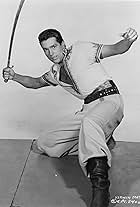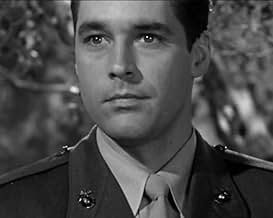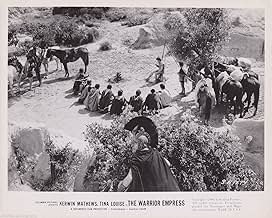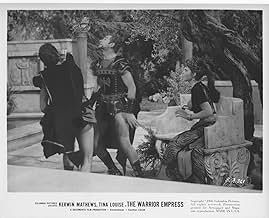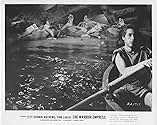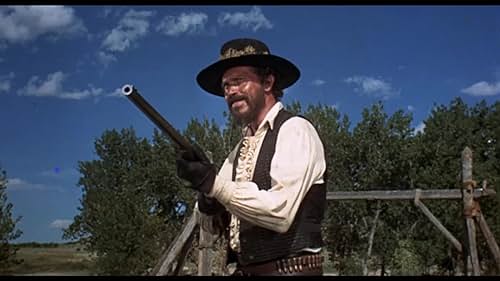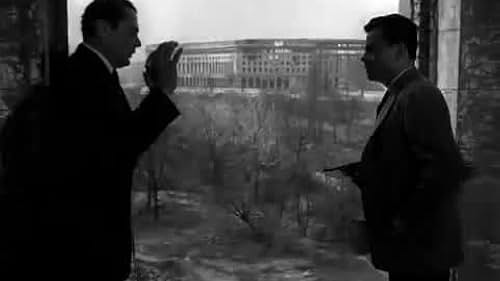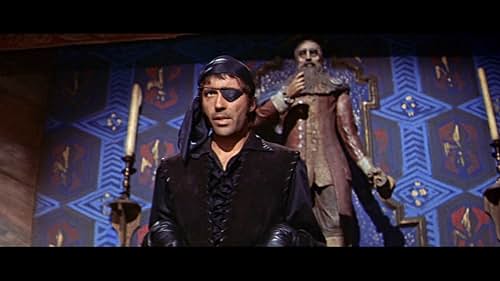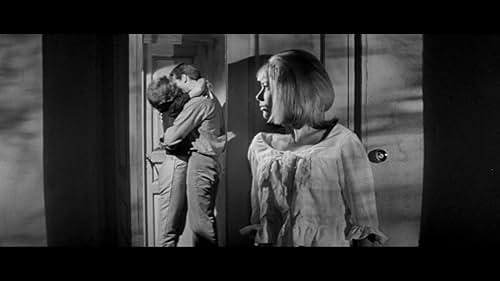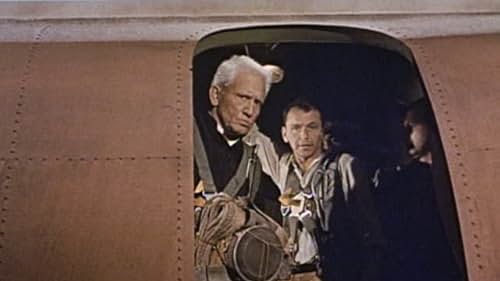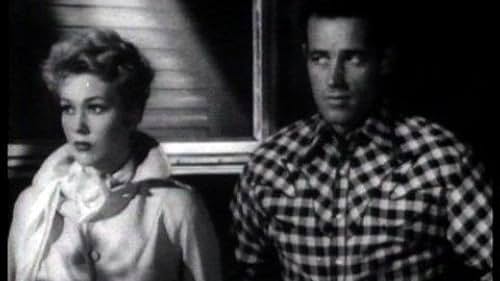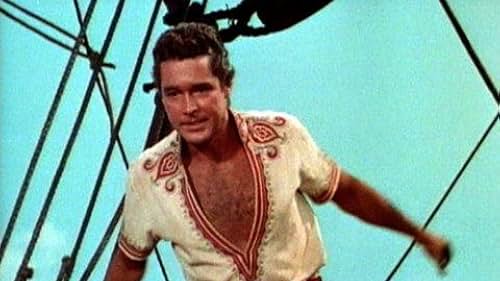Kerwin Mathews(1926-2007)
- Actor
Before there was a George Lucas and
Harrison Ford running around
creating special-effects excitement, there was a virile, boyishly
handsome actor named Kerwin Mathews who was entertaining audiences
battling a variety of creatures courtesy of pioneer special effects
guru Ray Harryhausen. Harryhausen's
legendary monsters of the late 50s and early 60s earned cult film
infamy and it was those wondrous storybook fantasies and the
Harryhausen association that also put Kerwin on the Hollywood map.
Born an only child in Seattle, Washington, on January 8, 1926, Kerwin's parents split up while he was quite young and he and his mother relocated to Janesville, Wisconsin. He developed an early interest in acting while performing in high school plays. Following a couple of years in the Army Air Force during WWII, Kerwin studied at Beloit College in Wisconsin on both dramatic and musical scholarships. He later taught speech and drama at the college and also found acting jobs in regional theater. In the early 1950s, after teaching high school English in Lake Geneva, Wisconin, for a few years, he decided to make the big trek to Hollywood to seek out his fame and fortune.
While training at the Pasadena Playhouse, Kerwin met a casting agent for Columbia Pictures and was eventually signed to a seven-year contact after winning over the approval of studio boss Harry Cohn. Finding a number of roles on TV, he acquitted himself quite well with his film debut in 5 Against the House (1955) as one of four college pals (the others being Guy Madison, Brian Keith and Alvy Moore) who decide to carry out a faux casino robbery in Las Vegas, a plan that backfires badly. The offbeat ensemble picture drew good reviews and Kerwin was off and running.
Following decent showings in the crime yarn The Garment Jungle (1957) and war flick Tarawa Beachhead (1958), he found respect as a middleweight talent, but truly came into his own in the Saturday afternoon-styled adventure fantasies popular with the school crowd. An agile fencer with fine all-American looks, he won the opportunity to play the role of the dauntless hero in Columbia's classic The 7th Voyage of Sinbad (1958). Out to rescue fair damsel Kathryn Grant (who later became Mrs. Bing Crosby), he battled everything in his path -- from a colossal, one-eyed Cyclops to a fire-spewing dragon. The final climactic battle scene was his Errol Flynn / Basil Rathbone-like swordplay against a dexterous, sword-swinging skeleton, all courtesy of Harryhausen.
Kerwin worked with Harryhausen's stop-motion creations again in The 3 Worlds of Gulliver (1960) as a doctor whose foes this time around included a giant squirrel and alligator. He then played the countrified folk legend Jack the Giant Killer (1962) and again found himself saving a princess while pitted against evil wizards and other specially-designed effects (by Jim Danforth). Other less arduous films he made included the WWII war drama The Last Blitzkrieg (1959) with Van Johnson, the crime thriller Man on a String (1960) with Ernest Borgnine and his third-billed role behind Spencer Tracy and Frank Sinatra in The Devil at 4 O'Clock (1961) in which he and Tracy played priests.
By the early 1960s Kerwin was typecast in adventure tales and was now searching for work overseas to display his stoic heroics, though his efforts were mostly for naught in such empty spectacles as Italy's The Warrior Empress (1960) ["The Warrior Princess"] opposite Gilligan's Island (1964) star Tina Louise; England's The Pirates of Blood River (1962); and the Franco-Italian co-production Shadow of Evil (1964) ["Panic in Bangkok"]. He fared somewhat better in the British-made Maniac (1963) in a change-of-pace role and received some of his best notices on TV playing composer Johann Strauss Jr. in Disney's 1963 TV biopic The Waltz King: Part 1 (1963) (and "Part 2").
Kerwin's career ended in 1978 after making a small sprinkling of appearances in low-budget sci-fi and horror films, plus some TV guest appearances throughout the decade. By this time he had already moved to San Francisco and spent his later years selling antiques and furniture. He was also a stalwart patron of the arts and supporter of the city's various opera and ballet companies. Kerwin died overnight in his sleep at age 81 in his San Francisco home, survived by his partner of 46 years Tom Nicoll.
Born an only child in Seattle, Washington, on January 8, 1926, Kerwin's parents split up while he was quite young and he and his mother relocated to Janesville, Wisconsin. He developed an early interest in acting while performing in high school plays. Following a couple of years in the Army Air Force during WWII, Kerwin studied at Beloit College in Wisconsin on both dramatic and musical scholarships. He later taught speech and drama at the college and also found acting jobs in regional theater. In the early 1950s, after teaching high school English in Lake Geneva, Wisconin, for a few years, he decided to make the big trek to Hollywood to seek out his fame and fortune.
While training at the Pasadena Playhouse, Kerwin met a casting agent for Columbia Pictures and was eventually signed to a seven-year contact after winning over the approval of studio boss Harry Cohn. Finding a number of roles on TV, he acquitted himself quite well with his film debut in 5 Against the House (1955) as one of four college pals (the others being Guy Madison, Brian Keith and Alvy Moore) who decide to carry out a faux casino robbery in Las Vegas, a plan that backfires badly. The offbeat ensemble picture drew good reviews and Kerwin was off and running.
Following decent showings in the crime yarn The Garment Jungle (1957) and war flick Tarawa Beachhead (1958), he found respect as a middleweight talent, but truly came into his own in the Saturday afternoon-styled adventure fantasies popular with the school crowd. An agile fencer with fine all-American looks, he won the opportunity to play the role of the dauntless hero in Columbia's classic The 7th Voyage of Sinbad (1958). Out to rescue fair damsel Kathryn Grant (who later became Mrs. Bing Crosby), he battled everything in his path -- from a colossal, one-eyed Cyclops to a fire-spewing dragon. The final climactic battle scene was his Errol Flynn / Basil Rathbone-like swordplay against a dexterous, sword-swinging skeleton, all courtesy of Harryhausen.
Kerwin worked with Harryhausen's stop-motion creations again in The 3 Worlds of Gulliver (1960) as a doctor whose foes this time around included a giant squirrel and alligator. He then played the countrified folk legend Jack the Giant Killer (1962) and again found himself saving a princess while pitted against evil wizards and other specially-designed effects (by Jim Danforth). Other less arduous films he made included the WWII war drama The Last Blitzkrieg (1959) with Van Johnson, the crime thriller Man on a String (1960) with Ernest Borgnine and his third-billed role behind Spencer Tracy and Frank Sinatra in The Devil at 4 O'Clock (1961) in which he and Tracy played priests.
By the early 1960s Kerwin was typecast in adventure tales and was now searching for work overseas to display his stoic heroics, though his efforts were mostly for naught in such empty spectacles as Italy's The Warrior Empress (1960) ["The Warrior Princess"] opposite Gilligan's Island (1964) star Tina Louise; England's The Pirates of Blood River (1962); and the Franco-Italian co-production Shadow of Evil (1964) ["Panic in Bangkok"]. He fared somewhat better in the British-made Maniac (1963) in a change-of-pace role and received some of his best notices on TV playing composer Johann Strauss Jr. in Disney's 1963 TV biopic The Waltz King: Part 1 (1963) (and "Part 2").
Kerwin's career ended in 1978 after making a small sprinkling of appearances in low-budget sci-fi and horror films, plus some TV guest appearances throughout the decade. By this time he had already moved to San Francisco and spent his later years selling antiques and furniture. He was also a stalwart patron of the arts and supporter of the city's various opera and ballet companies. Kerwin died overnight in his sleep at age 81 in his San Francisco home, survived by his partner of 46 years Tom Nicoll.
